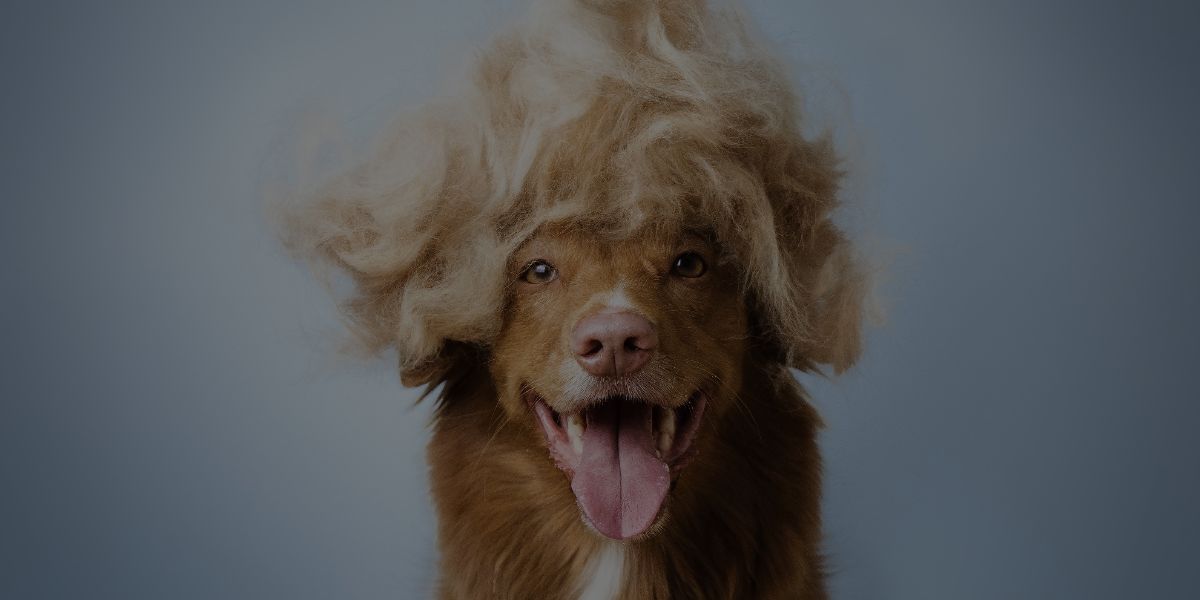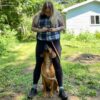I think we can all agree that dog groomers have an awesome – but important – job! Not only do they need to know how to properly groom a pup; they also need to be aware of their own mistakes. Making mistakes while grooming can not only be costly and time-consuming – it can also cause harm to the dog. Today, we’re going to take a look at 20 of the worst dog grooming mistakes YOU need to avoid making!
So, keep reading to find out what they are!
The 20 Worst Dog Grooming Mistakes to Make on the Job
Mistake #1: Not brushing the dog before getting them wet!
It’s important to brush out all the knots, mats, and tangles before you start working with a wet coat. Otherwise, it can cause pain for the dog and make your job harder. Not to mention, it could make a mess of the dog’s coat.
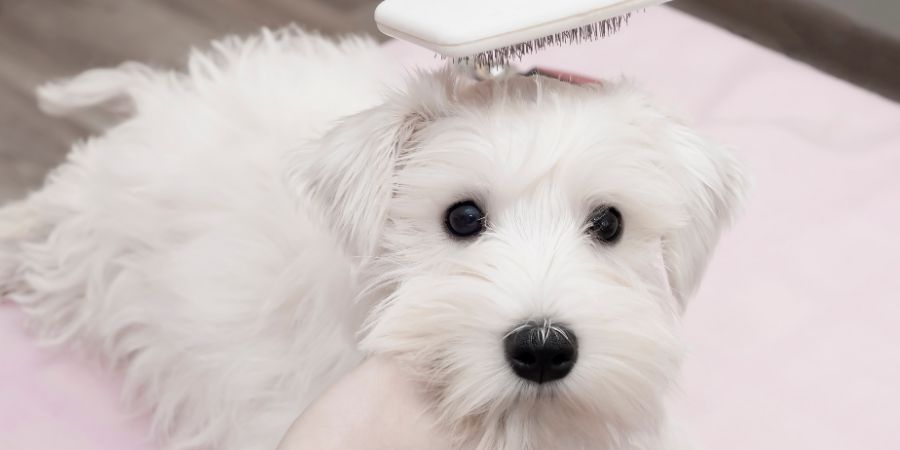
Mistake #2: Using the wrong shampoo and conditioner!
If you’re running your own dog grooming business, it’s CRITICAL to know that human-tailored shampoo and conditioner should NEVER be used on a pup. This is because they can strip the dog’s skin of its natural oils, leaving it dry and itchy.
Instead, make sure to use a shampoo and conditioner that’s specially formulated for dogs. This way, you can be sure your pup won’t suffer any unnecessary and unwanted damage.
Now, if you’re employed at a salon, chances are, you won’t run into this mistake as often. However, it’s still possible for you to choose the wrong shampoo or conditioner option, depending on the dog’s needs.
For instance, if you’re dealing with an older dog, it might be best to use a gentler product. Similarly, if your client’s dog has fleas, you’ll need to use a specialized shampoo to treat the issue.
Mistake #3: Using too much shampoo!
Even if you choose the right product, it’s important to remember that less is more when it comes to shampoo. Otherwise, you can end up leaving your pup feeling dry and irritated!
So, how can you know what the right amount to use is?
Generally, you’ll want to use just a small amount – enough that it can be evenly distributed throughout your pup’s coat. When pouring the shampoo, make sure to use a bottle with an adjustable nozzle, so that you don’t accidentally pour out too much. Once you’ve spread the product throughout the coat, you then can go ahead and lather it up.
Pro Tip: Not yet a professionally-trained, certified dog groomer? Our Step-by-Step Guide reveals how you can achieve this in as little as 6 easy steps!
Mistake #4: Not drying the dog properly!
It’s important to make sure your pup is completely dry after their bath. Otherwise, you put them at risk for skin diseases and infections, such as:
- Mange
- Hot spots
- Bacterial infections
- Fungal infections
To make sure your pup is properly dried, you’ll want to use a high-velocity dryer. This type of product will help to blow away all the moisture while also fluffing the pup’s coat.
For extra-thick fur, you’ll also want to use the right brush and comb combo. This will help to make sure every inch of their coat is dry – and not just the surface.
Mistake #5: Not brushing the dog’s coat after they’ve been dried!
Just like it’s important to brush the pup’s coat before they get wet, it’s key to brush them out after they’ve been dried, too.
This is because brushing helps to redistribute the natural oils in their fur – giving it a glossy shine and making it easier to manage. Plus, you’re also helping to remove any mats or tangles that may have formed while they were wet.
So, make sure to use the right brush for the job and take your time!
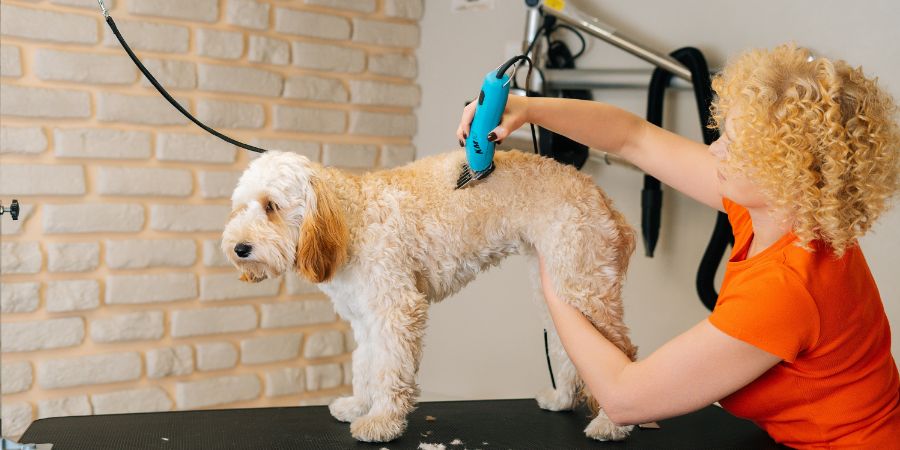
Mistake #6: Shaving a dog with a double coat!
A double coat is the kind of fur you’ll find on a Husky, Golden Retriever, or Malamute. This type of coat is soft and fluffy – but it’s also made up of two layers:
- An outer layer that repels water;
- And an inner layer that keeps the pup warm and dry.
Choosing to shave a double coat is tricky business for a couple reasons…
First of all, you don’t want to shave too much, too soon. Doing so can cause the inner layer of fur to become exposed and put your client’s pup at risk for sunburns, overheating, and other issues.
Secondly, if you shave a double coat too short, the pup can end up looking bald in some spots. This is because the inner layer of fur won’t grow back as quickly or thickly as the outer layer.
So, if you’re working with a double coat pup, you’ll want to just trim the outer layer of fur – leaving the inner layer intact. This way, you can keep them looking trim and tidy without compromising their comfort or health.
Mistake #7: Not having all the right dog grooming tools available!
In order to give your client’s pup a proper groom, you’ll want to make sure you have all the right tools handy. This includes:
- Brushes and combs
- Clippers and trimmers
- Nail clippers
- Shampoo and conditioner, etc.
Furthermore, if you operate your own grooming business, you’ll also need to make sure you have:
- A tub
- A proper grooming table
- Towels
- A high velocity dryer, etc.
Having all of these items on hand will help to ensure that you can properly groom your pup. At the same time, you’ll also be able to tackle any unexpected issues that may come up during the process.
So, make sure you have all of your supplies ready and waiting – before you start grooming any pup!
Pro Tip: Learn more about the BEST tools that every dog grooming professional needs!
Mistake #8: Failing to be thorough!
No matter the size of your client’s dog, you want to make sure that you cover every single inch of their coat. This means:
- Brushing and combing all the way down to the skin;
- Trimming their nails in just the right places;
- Cleaning the dog’s ears and eyes (if part of the groom);
- Making sure that their fur is evenly cut, etc.
- Tending properly to the sanitary areas;
- Making sure that any mats or tangles get fully untangled, etc.
If you’re not thorough, it can result in an unsatisfactory groom… And a dissatisfied client. So, make sure you take the time to pay attention to every detail – no matter how small.
Mistake #9: Not taking the dog’s breed into account!
When it comes to grooming, not all pups are created equal. Depending on the breed and coat type of your client’s pup, you’ll want to adjust your approach accordingly.
For example, a Schnauzer will need to be trimmed and clipped differently than a Shih Tzu. Similarly, a Labradoodle will need to be handled differently than a Bichon Frise.
Therefore, before you begin any grooming appointment, it’s important that you familiarize yourself with the pup’s breed-specific needs. This way, you can ensure that the groom meets your client’s expectations – as well as the pup’s needs.
Mistake #10: Not taking into account the dog’s medical needs!
Before you start ANY grooming appointment, it’s important to consider the dog’s medical needs. This includes:
- Allergies
- Injuries
- Sensitivities
- Skin diseases
- Fungal or bacterial infections, etc.
If you don’t take the time to learn about the dog’s medical history, you could end up hurting the pup – or making their condition worse.
So, make sure you always ask your client about any medical conditions their pup may have – before you begin the groom. This way, you can adjust your techniques accordingly and make sure that your client’s pup is as safe and comfortable as possible.
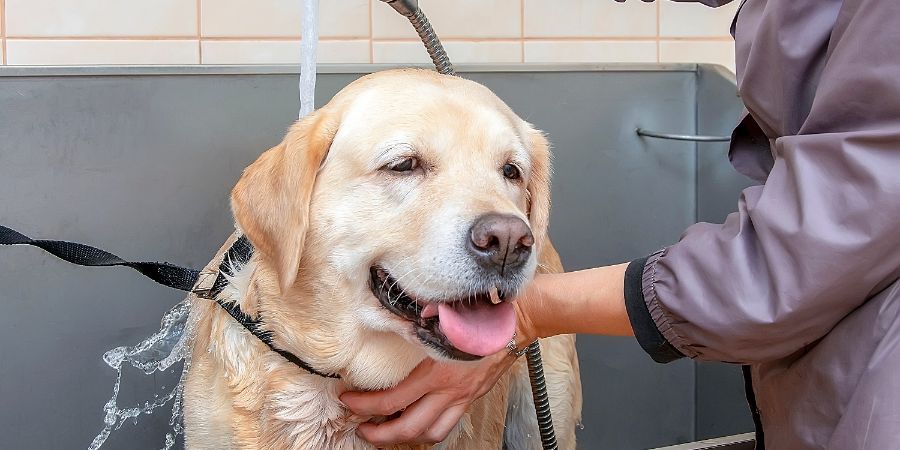
Mistake #11: Cutting the dog’s nails too short!
When it comes to trimming a dog’s nails, you’ll want to be extra cautious. This is because cutting too short can cause the nail to bleed… And this will definitely cause pain and discomfort for the pup!
So, make sure you have a proper plan when it comes to trimming their nails. This includes:
- Getting the right tools;
- Having a steady hand;
- Being able to spot the quick;
- Knowing the proper length to trim, etc.
If you’re ever unsure, it’s best to err on the side of caution and leave them a bit longer. This way, you won’t risk hurting your client’s pup or ruining their groom.
Pro Tip: Learn how to cut dogs’ nails correctly with the help of our Beginner’s Guide!
Mistake #12: Cleaning the ears wrong!
There’s a common misconception that when cleaning a dog’s ears, you should stick a Q-tip (or something similar) into the ear canal. However, this is actually one of the worst things you can do! This is because going too deep or cleaning with too much force could cause further damage to their ears.
Furthermore, it can be dangerous to introduce water or chemicals into the dog’s actual ear canals. Instead, what you want to do is:
- Gently clean the visible areas of their ears;
- Use a specialized ear cleaning solution, if needed;
- And be careful not to go too deep.
If you need help, it’s always best to consult with a veterinarian first – before attempting any kind of ear cleaning. This way, you’ll know exactly how to clean the pup’s ears safely and effectively.
Mistake #13: Not understanding canine behavior and body language!
When it comes to dog grooming, it’s crucial that you take the time to understand canine behavior – as well as their body language.
After all, dogs will often communicate their stress and discomfort through subtle changes in their posture and behavior. For example, if they feel threatened or scared, they might start panting heavily, tucking their tail, or even growling.
Therefore, it’s important that you take the time to get to know the pup before starting their groom – as well as paying attention throughout the entire process. This way, if they ever feel uncomfortable or scared, you’ll be able to recognize it and adjust your approach accordingly.
Mistake #14: Not being able to handle difficult dogs!
No matter how experienced you may be, there’s always going to be some pups that are more challenging than others.
In these cases, it’s important that you have the skill and knowledge needed to handle difficult dogs – in order to ensure their safety as well as your own. This includes learning how to:
- Read dog body language;
- Use positive reinforcement techniques;
- Understand the root of their behavior;
- Know when to call for help, etc.
These are all important things to consider when dealing with difficult dogs – so make sure you have the proper skills and knowledge before starting your groom. This way, you can be sure that both you and the pup will remain safe throughout the process!
Mistake #15: Getting product in the dog’s eyes!
Certain products (such as shampoo and conditioner) can get into the pup’s eyes during a groom if you’re not careful. And while this might sound harmless, it can actually be quite painful – as well as dangerous – for the pup!
For this reason, you need to take extra precautions when bathing your canine client. This includes:
- Using eye protection;
- Making sure that all products are well rinsed;
- Being gentle and careful around the eye area, etc.
By taking these steps, you’ll be able to make sure that no product gets in their eyes – keeping them safe and comfortable throughout the entire groom.
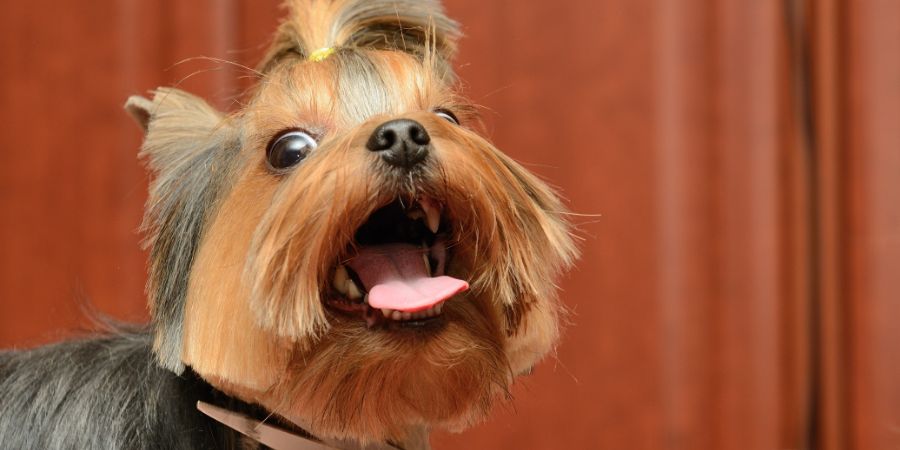
Mistake #16: Not knowing canine First Aid!
While on the topic of safety, it’s also important that you have a basic understanding of canine First Aid. The fact is, accidents can (and do) happen on the job. As such, it’s best to be prepared for any potential emergencies or injuries.
This includes learning:
- How to control bleeding;
- How to perform CPR if they stop breathing;
- The Heimlich Maneuver for dogs in case they’re choking;
- When to call the vet;
- And what first aid supplies to keep on-hand, etc.
As a professional dog groomer, it’s critical that you take the time to familiarize yourself with canine First Aid. This way, you’ll be able to respond quickly and efficiently in case of an emergency – saving valuable time and potentially even a pup’s life!
Did you know that as part of QC Pet Studies’ self-paced, online Dog Grooming certification course, you’ll also get our First Aid Course absolutely FREE? It’s true!
Mistake #17: Not being prepared for a worst-case scenario!
No matter how much experience you may have as a dog groomer, it’s important that you always be prepared for the unexpected. This includes making sure that you:
- Have emergency contact information on hand;
- Know what to do if a pup has an allergic reaction;
- Keep basic medical supplies on hand, etc.
By taking the time to plan ahead, you’ll be able to respond quickly and effectively in case of an emergency – keeping both you and your canine clients safe.
Mistake #18: Not knowing how to handle a bite!
No matter how gentle and well-trained your client’s pup may seem, it’s important to remember that they are still animals. And as such, there is always a chance that they may bite if they feel scared or threatened.
For this reason, you need to be prepared for any potential biting situations. This includes:
- Learning about canine body language;
- Understanding the root of their behavior;
- Knowing when to give the dog some space;
- Knowing when to call for help, etc.
So long as you have a plan in place and familiarize yourself with the proper techniques, you’ll be able to respond quickly and effectively. Thus, you can ensure safety for both you and your canine clients!
Mistake #19: You can’t handle constructive criticism!
No matter how experienced and skilled you may be, it’s important to remember that there is always room for improvement. And while it can sometimes be hard to take constructive criticism, the fact is that it’s an essential part of any job – especially in dog grooming!
If a client or fellow groomer has something to say about your work, take it in stride. Not only will this help you be more open-minded and flexible; it can also help you become a better groomer overall!
Mistake #20: Attempting ANY techniques you haven’t actually been trained in!
Full stop – this is why all professional dog groomers should be properly trained and certified, in our opinion. Attempting complex or dangerous grooming techniques without the proper education can lead to serious injury – both for you and your canine clients.
Not to mention, even if no harm comes to you or the dog, the results can be embarrassing. Think of all the potential ways a haircut or dye job could go wrong if you aren’t properly trained!
At the end of the day, it’s best to stick with techniques and grooming products that you’ve been educated on. This way, you can be sure to get reliable results – every single time.
And if you want to be able to do it ALL?
Well, that’s where QC Pet Studies‘ Dog Grooming certification course comes in! Our self-paced, online program will teach you everything from basic grooming to complex clipping… So that you can become a top-notch dog groomer in no time!
Check out this course review to see how QC’s Dog Grooming program helped graduate, April Costigan, launch a successful career as a groomer!
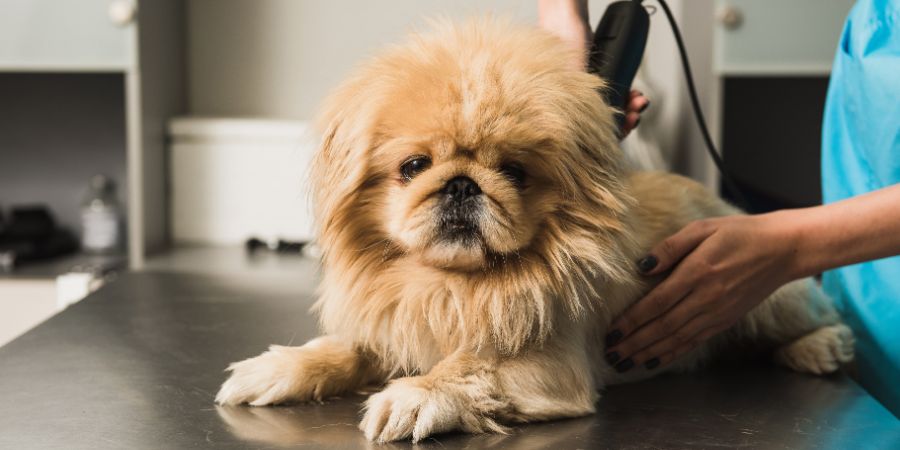
Frequently Asked Questions
Q: What should you not do when grooming a dog for the first time?
A: When grooming a dog for the first time, it’s important to avoid making any of the 20 mistakes listed above – such as using equipment that is too sharp or attempting techniques you haven’t been trained in.
Beyond that, it’s also important to take your time and be patient. Grooming can be a stressful experience for some pups. So, it helps to go slow and provide plenty of reassurance as you work.
Q: What are some safety tips to keep in mind when grooming dogs?
A: Some safety tips to keep in mind when grooming dogs include:
- Ensuring the dog is comfortable and secure at all times;
- Being aware of your surroundings (especially if there are other animals present, the dog has a grooming loop around its neck, etc.);
- Keeping basic medical supplies on hand in case of an emergency;
- Not attempting any techniques you haven’t been trained in;
- Knowing how to properly handle a dog if it bites, etc.
Of course, these are just a few tips… Obviously, there’s plenty more to consider when it comes down to safety! Ultimately, the goal is to ensure that you, the groomer, and your canine clients remain safe throughout the grooming process.
Q: What dog breeds should not be groomed?
A: Generally speaking, any breed of dog can be groomed. However, it’s important to keep in mind that some breeds may require more experience and/or specialized tools.
For instance, certain Terriers and toy breeds are known for having coats that can easily become matted or tangled. Thus, they may need extra attention and patience during the grooming process.
In addition, some dog breeds are more naturally prone to aggression than others – such as Bull Terriers and Chows. So it’s important to take extra safety precautions when handling these types of dogs.
Ultimately, it’s best to research the breed you’re about to groom before starting the process – just in case there are any special considerations you need to keep in mind.
Q: What is the hardest part of dog grooming?
A: The hardest part of dog grooming is often the clipping and trimming. This requires a steady hand, patience, and the proper tools in order to get the job done correctly – without causing any harm to your canine clients.
In addition, it’s also important to be aware of how different coat types require different levels of care. For instance, some breeds may need to be shaved more often than others.
Therefore, it’s important to have a good understanding of various coats so that you can provide the best possible grooming experience for your clients – every single time!
Q: What are some signs of a bad groomer?
A: Some signs of a bad groomer include (but aren’t limited to):
- Using equipment that is too sharp or outdated;
- Not taking the time to properly sanitize their tools;
- Rushing through grooming sessions;
- Not paying attention to safety precautions;
- Being impatient and/or rough with the dog.
For instance, if you notice that your groomer is rushing through the grooming session, or not taking the time to properly sanitize their tools – it might be a good idea to look for another groomer.
Pro Tip: Find the right dog groomer for YOU in just 5 simple steps!
Q: What are the most common mistakes when grooming a dog at home?
A: The most common mistakes when grooming a dog at home include:
- Not using the right tools;
- Using supplies that are too old or outdated;
- Attempting to groom a breed you don’t have experience with;
- Not being aware of safety precautions (such as how to properly handle a dog if it bites, etc.);
- Not taking the time to properly sanitize and clean your tools;
- Rushing through the grooming process, etc.
It’s important to remember that grooming a dog isn’t as simple as it may seem. There are many intricate details you need to be aware of – such as what type of coat each breed has, how often certain breeds need to be groomed, and so on.
Therefore, it’s best to do your research before attempting any grooming techniques at home – or better yet, contact a professional groomer for assistance!
Q: What is the MOST important thing to remember when grooming a dog?
A: The most important thing to remember when grooming a dog is safety. This means taking the necessary precautions to ensure that you (the groomer) and your canine client remain safe throughout the entire process.
This also entails being aware of any potential risks that could arise – such as how to safely handle a dog if it bites, etc.
It’s also important to remember that you should use proper equipment and take the time to sanitize any tools used during the grooming session. Finally, it’s essential to keep in mind that different breeds require different levels of care. So, it pays off to do your research!
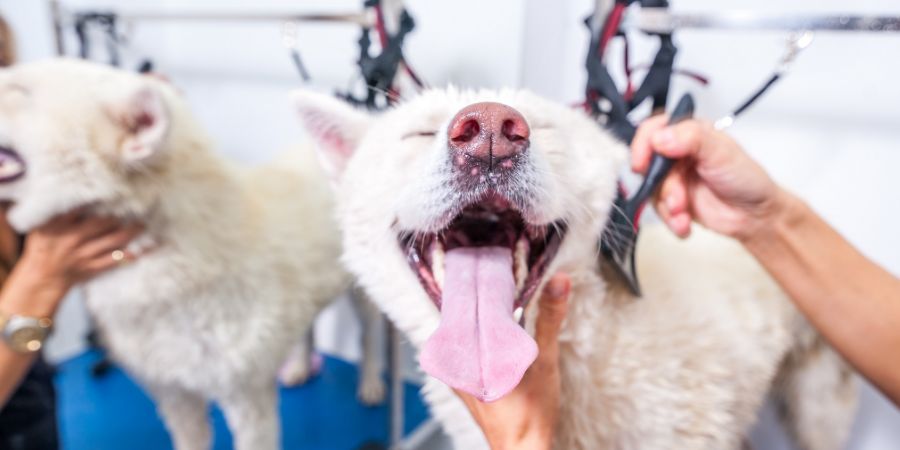
Final Thoughts
No matter how experienced you may be, it’s important to remember that grooming a dog is no simple task. Hopefully, now that you know these 20 dog grooming mistakes to avoid, you’ll be able to navigate the process with confidence.
Above all, take proper safety precautions and always do your best to treat each dog with respect – as you would any other client in your care.
Thanks for reading, and happy grooming!
